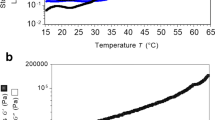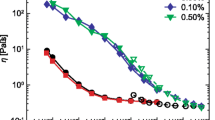Abstract
Rheological measurements were performed to examine the yielding behavior of capillary suspensions prepared by mixing cocoa powder as dispersed phase, vegetable oil as the continuous primary fluid, and water as the secondary fluid. Here, we investigated the yielding behavior of solid-fluid-fluid systems with varying particle volume fraction, ϕ, spanning the regime from a low volume fraction (ϕ = 0.25) to a highly filled regime (ϕ = 0.65) using dynamic oscillatory measurements. While for ϕ ≤ 0.4 with a fixed water volume fraction (ϕ w ) of 0.06 as the secondary fluid, capillary suspensions exhibited a single yield point due to rupturing of aqueous capillary bridges between the particles, while capillary suspensions with ϕ ≥ 0.45 showed a two-step yielding behavior. On plotting elastic stress (G′ γ) as a function of applied strain (γ), two distinct peaks, indicating two yield stresses, were observed. Both the yield stresses and storage modulus at low strains were found to increase with ϕ following a power law dependence. With increasing ϕ w (0 – 0.08) at a fixed ϕ = 0.65, the system shifted to a frustrated, jammed state with particles strongly held together shown by rapidly increasing first and second yield stresses. In particular, the first yield stress was found to increase with ϕ w following a power law dependence, while the second yield stress was found to increase exponentially with ϕ w . Transient steady shear tests were also performed. The single stress overshoot for ϕ ≤ 0.4 with ϕ w = 0.06 reflected one-step yielding behavior. In contrast, for high ϕ (≥ 0.45) values with ϕ w = 0.06, two stress overshoots were observed in agreement with the two-step yielding behavior shown in the dynamic oscillatory measurements. Experiments on the effect of resting time on microstructure recovery demonstrated that aggregates could reform after resting under quiescent conditions.









Similar content being viewed by others
References
Ahuja A, Zylyftari G, Morris JF (2014) Calorimetric and rheological studies on cyclopentane hydrate-forming water-in-kerosene emulsions. J Chem Eng Data 60:362
Ahuja A, Zylyftari G, Morris JF (2015) Yield stress measurements of cyclopentane hydrate slurry. J Non–Newtonian Fluid Mech 220:116
Ahuja A (2015) Hydrate forming emulsion: Rheology and morphology analysis for flow assurance. PhD Thesis, City University of New York, New York
Bossler F, Koos E (2016) Structure of particle networks in capillary suspensions with wetting and nonwetting fluids. Langmuir 32:1489
Bossler F, Weyrauch L, Schmidt R, Koos E (2017) Influence of mixing conditions on the rheological properties and structure of capillary suspensions. Colloids Surf A Physicochem Eng Asp 518:85– 97
Chan HK, Mohraz A (2012) Two-step yielding and directional strain-induced strengthening in dilute colloidal gels. Phys Rev E 85:041403
Datta SS, Gerrard DD, Rhodes TS, Mason TG, Weitz DA (2011) Rheology of attractive emulsions. Phys Rev E 84:041404
Domenech T, Velankar SS (2015) On the rheology of pendular gels and morphological developments in paste-like ternary systems based on capillary attraction. Soft Matter 11:1500
Hoffmann S, Koos E, Willenbacher N (2014) Using capillary bridges to tune stability and flow behavior of food suspensions. Food Hydrocolloids 40:44
Karanjkar PU, Ahuja A, Zylyftari G, Lee JW, Morris JF (2016) Rheology of cyclopentane hydrate slurry in a model oil-continuous emulsion. Rheol Acta 55:235
Koos E, Willenbacher N (2011) Capillary forces in suspension rheology. Science 331:897
Koos E, Johannsmeier J, Schwebler L, Wiillenbacher N (2012) Tuning suspension rheology using capillary forces. Soft Matter 8:6620
Koos E, Kannowade W, Willenbacher N (2014) Restructuring and aging in a capillary suspension. Rheol Acta 53:947
Koos E (2014) Capillary suspensions: particle networks formed through the capillary force. Curr Opin Colloid Interface Sci 19: 575
Koumakis N, Petekidis G (2011) Two step yielding in attractive colloids: transition from gels to attractive glasses. Soft Matter 7:2456
Segovia-Gutiérrez JP, Berli CLA, De Vicente J (2012) Nonlinear viscoelasticity and two-step yielding in magnetorheology: A colloidal gel approach to understand the effect of particle concentration. J Rheol 56:1429
Sentjabrskaja T, Babaliari E, Hendricks J, Laurati M, Petekidis G, Egelhaaf SU (2013) Yielding of binary colloidal glasses. Soft Matter 9:4524
Shao Z, Negi AS, Osuji CO (2013) Role of interparticle attraction in the yielding response of microgel suspensions. Soft Matter 9: 5492
Shukla A, Arnipally S, Dagaonkar M, Joshi YM (2015) Two-step yielding in surfactant suspension pastes. Rheol Acta 54:353–364
Walls HJ, Caines SB, Sanchez AM, Khan SA (2003) Yield stress and wall slip phenomena in colloidal silica gels. J Rheol 47(4):847
Wollgarten S, Yuce C, Koos E, Willenbacher N (2016) Tailoring flow behavior and texture of water based cocoa suspensions. Food Hydrocolloids 52:167
Yang J, Velankar S (2017) Preparation and yielding behavior of pendular network suspensions. J Rheol 61:217
Zhao C, Yuan G, Han JCC (2014) Bridging and caging in mixed suspensions of microsphere and adsorptive microgel. Soft Matter 10:8905
Zhou Z, Hollingsworth JV, Hong S, Cheng H, Han CC (2014) Yielding behavior in colloidal glasses: comparison between hard cage and soft cage. Langmuir 30:5739
Zylyftari G, Lee JW, Morris JF (2013) Salt effects on thermodynamic and rheological properties of hydrate forming emulsions. Chem Eng Sci 95:148
Zylyftari G, Ahuja A, Morris JF (2015) Modeling oilfield emulsions: comparison of cyclopentane hydrate and ice. Energy Fuels 29:6286
Acknowledgments
The authors appreciate discussions with Megha Goyal regarding the selection of low-fat cocoa powder and vegetable oil. We are also thankful to Prof. Jeffrey Morris (CUNY) for numerous useful discussions.
Author information
Authors and Affiliations
Corresponding author
Rights and permissions
About this article
Cite this article
Ahuja, A., Gamonpilas, C. Dual yielding in capillary suspensions. Rheol Acta 56, 801–810 (2017). https://doi.org/10.1007/s00397-017-1040-1
Received:
Revised:
Accepted:
Published:
Issue Date:
DOI: https://doi.org/10.1007/s00397-017-1040-1




